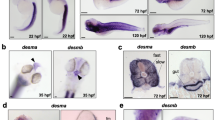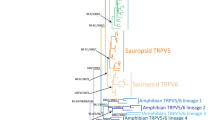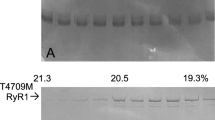Abstract
SKELETAL muscle is unusual in that 70–85% of resting membrane conductance is carried by chloride ions1. This conductance is essential for membrane-potential stability, as its block by 9-anthracene-carboxylic acid and other drugs causes myotonia2,3. Fish electric organs are developmentally derived from skeletal muscle, suggesting that mammalian muscle may express a homologue of the Torpedo mamorataelectroplax chloride channel4,5. We have now cloned the complementary DNA encoding a rat skeletal muscle chloride channel by homology screening to the Cl− channel from Torpedo4 (Fig. la). It encodes a 994-amino-acid protein which is about 54% identical to the Torpedo channel and is predominantly expressed in skeletal muscle. Messenger RNA amounts in that tissue increase steeply in the first 3–4 weeks after birth, in parallel with the increase in muscle Cl− conductance6. Expression from cRNA in Xenopus oocytes leads to 9-anthracene-carboxylic acid-sensitive currents with time and voltage dependence typical for macroscopic muscle Cl− conductance. This and the functional destruction of this channel in mouse myotonia7suggests that we have cloned the major skeletal muscle chloride channel.
This is a preview of subscription content, access via your institution
Access options
Subscribe to this journal
Receive 51 print issues and online access
$199.00 per year
only $3.90 per issue
Buy this article
- Purchase on Springer Link
- Instant access to full article PDF
Prices may be subject to local taxes which are calculated during checkout
Similar content being viewed by others
References
Bretag, A. H. Physiol. Rev. 67, 618–724 (1987).
Rüdel, R. & Lehmann-Horn, F. Physiol. Rev. 65, 310–356 (1985).
Bryant, S. H. & Morales-Aguilera, A. J. Physiol., Lond. 219, 367–383 (1971).
Jentsch, T. J., Steinmeyer, K. & Schwarz, G. Nature 348, 510–514 (1990).
Miller, C. & Richard, E. A. in Chloride Channels and Carriers in Nerve, Muscle, and Glial Cells (eds Alvarez-Leefsmans, F. J. & Russel, J. M.) 383–405 (Plenum, New York, 1990).
Conte Camerino, D., De Luca, A., Mambrini, M. & Vrbovà, G. Pflügers Arch. 413, 568–570 (1989).
Steinmeyer, K. et al. Nature 354, 304–308 (1991).
Kyte, J. & Doolittle, R. F. J. molec. Biol. 157, 105–132 (1982).
Kimes, B. W. & Brandt, B. L. Expl Cell Res. 98, 349–366 (1976).
Cooperman, S. S. et al. Proc. natn. Acad. Sci. U.S.A. 84, 8721–8725 (1987).
Trimmer, J. S. et al. Neuron 3, 33–49 (1989).
Trimmer, J. S., Cooperman, S. S., Agnew, W. S. & Mandel, G. Devl Biol. 142, 360–367 (1990).
Kallen, R. L. et al. Neuron 4, 233–242 (1990).
Mishina, M. et al. Nature 321, 406–411 (1986).
Witzemann, V., Barg, B., Criado, M., Stein, E. & Sakmann, B. FEBS Lett. 242, 419–424 (1989).
Palade, P. T. & Barchi, R. L. J. gen. Physiol. 69, 325–342 (1977).
Miller, C. Phil. Trans. R. Soc. B 299, 401–411 (1982).
Miller, C. & White, M. M. Proc. natn. Acad. Sci. U.S.A. 81, 2772–2775 (1984).
Bauer, C. K., Steinmeyer, K., Schwarz, J. R. & Jentsch, T. J. Proc. natn. Acad. Sci. U.S.A. (in the press).
Blatz, A. L. & Magleby, K. L. Biophys. J. 43, 237–241 (1983).
Blatz, A. L. & Magleby, K. L. Biophys. J. 47, 119–123 (1985).
Kozak, M. Nucleic Acids Res. 12, 857–872 (1984).
Colman, A. in Transcription and Translation (eds Hames, B. D. & Higgins, S. J.) 271–302 (IRL, Oxford, 1984).
Higuchi, R. in PCR Technology (ed. Erlich, H. A.) 61–70 (Stockton, New York, 1989).
Author information
Authors and Affiliations
Rights and permissions
About this article
Cite this article
Steinmeyer, K., Ortland, C. & Jentsch, T. Primary structure and functional expression of a developmentally regulated skeletal muscle chloride channel. Nature 354, 301–304 (1991). https://doi.org/10.1038/354301a0
Received:
Accepted:
Issue Date:
DOI: https://doi.org/10.1038/354301a0
This article is cited by
-
Non-dystrophic myotonias: clinical and mutation spectrum of 70 German patients
Journal of Neurology (2021)
-
Skeletal muscle ClC-1 chloride channels in health and diseases
Pflügers Archiv - European Journal of Physiology (2020)
-
A large intragenic deletion in the CLCN1 gene causes Hereditary Myotonia in pigs
Scientific Reports (2019)
-
Taurine: the appeal of a safe amino acid for skeletal muscle disorders
Journal of Translational Medicine (2015)
-
A nitrate-permeable ion channel in the tonoplast of the moss Physcomitrella patens
Planta (2015)
Comments
By submitting a comment you agree to abide by our Terms and Community Guidelines. If you find something abusive or that does not comply with our terms or guidelines please flag it as inappropriate.



